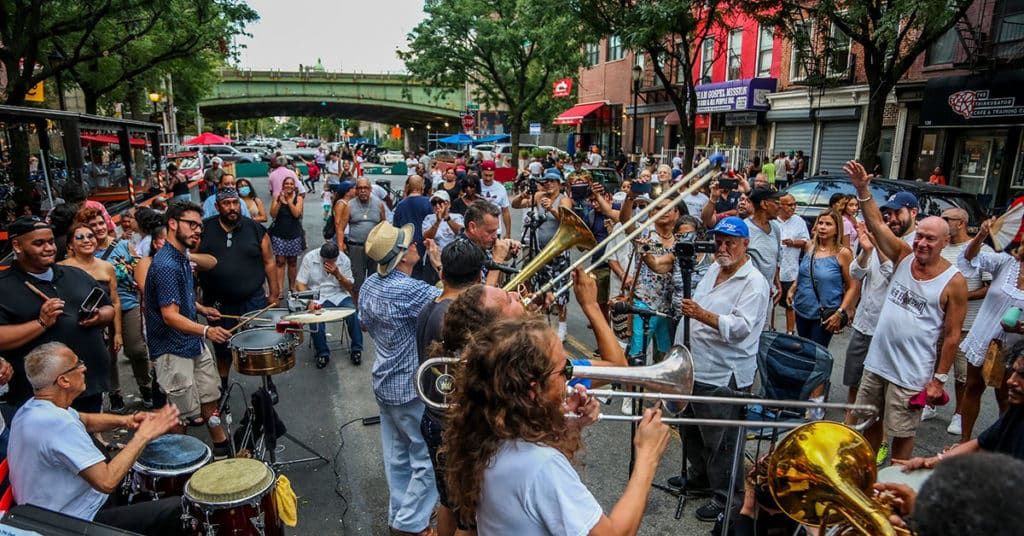Salsa Stories Sound of Light Edition is an immersive multimedia Salsa block party. It brings Salsa music and dancing, free dance classes, photo and video exhibitions, to the New York City streets where Salsa as we know it today was born.

- Salsa Stories Sound of Light Edition South Bronx is at the Open Street on Kelly St (between Ave St John & Legget Ave) in Longwood, The Bronx, on Friday, August 26 | September 2, 9, 16, 23 & 30 | October 7 and 14, 2022, from 6-8pm. Free. 🇧🇷🇨🇴🇨🇺🇩🇴🇵🇦🇵🇪🇵🇷🇻🇪🗽
- Salsa Stories Sound of Light Edition East Harlem is at the Open Street on East 115th St (between First Ave & Pleasant Ave) in “El Barrio” East Harlem, on Saturday, August 27 | September 3, 10, 17 & 24 | October 1, 8 & 15, 2022, from 5-7pm. Free. 🇧🇷🇨🇴🇨🇺🇩🇴🇵🇦🇵🇪🇵🇷🇻🇪🗽
- Salsa Stories Sound of Light Edition Lower East Side is at the Open Street in front of The Clemente on Suffolk St (between Rivington & Delancey) in “Loisaida” the Lower East Side, on Sunday, August 28 | September 4, 11, 18 & 25 | October 2, 9 & 16, 2022, from 3-6pm. Free. 🇧🇷🇨🇴🇨🇺🇩🇴🇵🇦🇵🇪🇵🇷🇻🇪🗽
The Salsa Story
Salsa is 1950s Cuban Son dance music that developed into Salsa in New York City’s Puerto Rican communities in the 1960s and 70s before jumping to Colombia and going worldwide. Artists from many Caribbean countries and Peru contributed to Salsa’s development, but without the influence of New York Puerto Rican Bomba and Plena, it’s not Salsa. Oh, and Salsa is New York City music.
Interestingly New York Puerto Rican composer Tite Curet Alonso, the Salsa Poet who wrote many of the most famous Fania Salsa hits, said he was influenced a lot by Brazilian Samba. That makes sense because Salsa derives from Cuban Yoruba traditions with Puerto Rican influences, Haitian Méringue & Dominican Merengue derive from the Dahomey traditions of the Haitian Diaspora, and Samba derives from Brazilian Candomblé traditions. We are all related through the African Diaspora.
Salsa Stories is produced by Brazilian award-winning video producer and salsera Bianka Cypriano. In 2017, Bianka began recording oral histories for her “Salsa Stories” documentary. That’s important because we are now losing the founding generation.
When the Covid pandemic stopped everything, Bianka decided to take her work to the streets. That became the first edition of Salsa Stories in 2021. You can watch Bianka’s “Salsa Stories” TV series on CUNY TV and BronxNet.
In New York City, performing arts are usually presented in theaters, but Latin music’s natural habitat is the living room, backyard, patio, field, beach, town square, or just the street.
The most beautiful thing about African Diaspora drum, song and dance traditions is that they are not really about drumming, singing and dancing. The traditions are about being together as a community.
Salsa Stories Sound of Light Edition
Salsa Stories Sound of Light Edition brings community back to the streets of New York. It’s perfect. Bianka is a genius. Why hasn’t anyone done this before? It took an NYC video producer to see the possibilities.
The Sound of Light Edition uses video game technology to translate the dancer’s movements into an interactive light show that projects watery figures onto the surrounding buildings.
Water is important because in traditional cultures in Mother Africa and around the world, rivers are sacred. In the African Diaspora, the sanctity of rivers was transferred to the oceans because we and our culture were brought to the Americas across the Atlantic.
The Center for Puerto Rican Studies at Hunter College contributed archival images, and Bianka commissioned some new media works.
Designer Melissa Ulto added an Augmented Reality (AR) dimension to the project which you can experience on site, or through your own AR viewer and Membit app.
The New York City Department of Transportation (Open Streets), Enfoco photo collective, Creatives Build New York, Alfresco NYC and the City Parks Foundation all worked together to make Salsa Stories come to life.
Salsa Stories Sound of Light Edition is in Historic Salsa Locations
Bianka chose locations that contributed to Salsa history in the South Bronx, “El Barrio” East Harlem and the Lower East Side.
The South Bronx location is the street in front of the former public school PS 52 where Salsa legends like Mike Amadeo (Casa Amadeo / Antigua Casa Hernandez music store), Eddie Palmieri and many other future Latin musicians went to school. A whole crop of Latin musicians grew up together there.
The Lower East Side (Loisaida) around The Clemente is another important location in Salsa history.
The Salsa Stories documentary project is ongoing. Learn more about it at salsastoriestv.com
